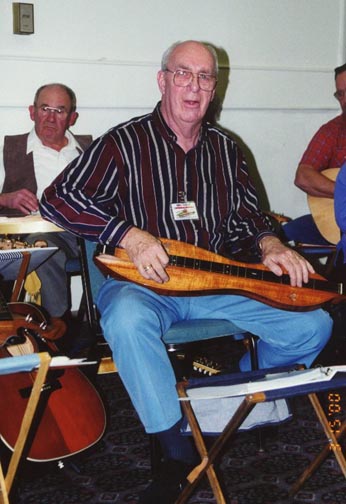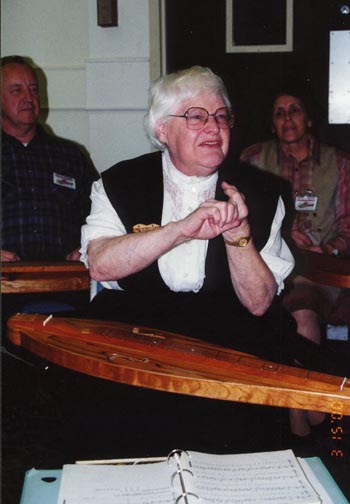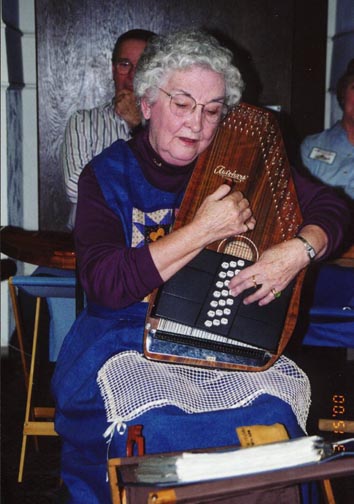

The Hills of Kentucky Dulcimers
The Hills of Kentucky Dulcimers began with ten players in July, 1992. Now there are over 100 members, ranging in age from 12 to 80+. Our mission is to educate and entertain the public about traditional mountain instruments and the beautiful music played on mountain dulcimers. Perhaps 50% of the clubs' players have played an instrument before learning the dulcimer - some had piano lessons or were in band as kids. Traditional dulcimer music was written by non musicians. We learn to "play by numbers" that correspond to the segments on dulcimer fretboards. The Hills of Kentucky Dulcimers meet, learn and practice on the first and third Thursdays of each month, and there are lessons for beginners.

Mal Cobb, Erlanger, Kentucky
History of the Appalachian Dulcimer
The fretted Appalachian dulcimer has been handed down by the people of the southern Appalachian mountains. It belongs to a class of instruments known as fretted zithers. The oldest direct ancestor of the Appalachian dulcimer may be the German "scheitholt," a diatonically fretted zither from the 1400s. The Appalachian dulcimer also uses a diatonic scale, which does not have all of the flats and sharps that our modern chromatic scale has.
The history of the dulcimer follows the trail of the Appalachian settlers. Large numbers of German people migrated to Pennsylvania by invitation of Governor William Penn, beginning around 1710. By 1729, the Germans were joined by Scots, Irish and English. Available land in eastern Pennsylvania soon became scarce and costly, and migration into the Appalachian area began. The immigrants followed wagon roads which ran from New York to Georgia, and many settled in the hills and mountains along those routes.

explaining the history of the instrument
What instruments did they bring to the Appalachians? The Scots, Irish and English brought fiddles, on which they played ballads and fast dance music. The Germans brought scheitholts, on which they played mostly hymns, since these zithers were not well adapted for fast music. Folk musicians and dulcimer historians like Ralph Lee Smith believe that the early settlers developed a new instrument with a large sound box and raised fret board that was well suited for faster tunes. These crude dulcimers began to appear in the secluded coves and "hollers" of Appalachia. We don't know the exact date of the first dulcimer, but we do know that it can be considered - like the banjo - to be a truly American instrument.
Early dulcimer makers strung wire over a piece of plank wood; then frets made of safety pins were added under the melody string. Dulcimers are still individually hand made. The sound holes were originally shaped to symbolize the type of music you wanted to make: the heart sound holes were for love songs; the crosses for hymns (and considered sacrilegious to be used for other music); the butterflies or flowers for songs about nature but never about people. Wood was often determined simply by what was plentiful or available, but different woods do produce different tones - cherry makes a soft sound, mahogany makes a bright sound. The size of the box also affects the sound - the deeper it is, the greater the bass sound.

demonstrating the Autoharp
The early dulcimer has evolved into what we play today, and the instrument continues to change. Most dulcimers now have geared metal tuners instead of wooden pegs. New frets - 6 1/2 and 13 1/2 -- make playing modem scales more possible. For many years, the dulcimer was little known outside of the Appalachian Mountains. By 1928, missionary and charity workers reported a "quaint instrument" in the hills, which they thought would soon be extinct. Luckily, a dulcimer revival began in the 1950s when Jean Ritchie of Viper, Kentucky brought the dulcimer from the mountains into the college and radio scene.
Excerpted, in part, from the history written by Sharon Eggemeier and Ann Startz, Hills of Kentucky Dulcimers
![]()
Return to Northern Kentucky Elderhostel page
![]()